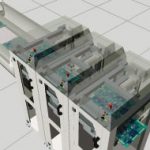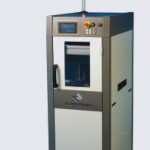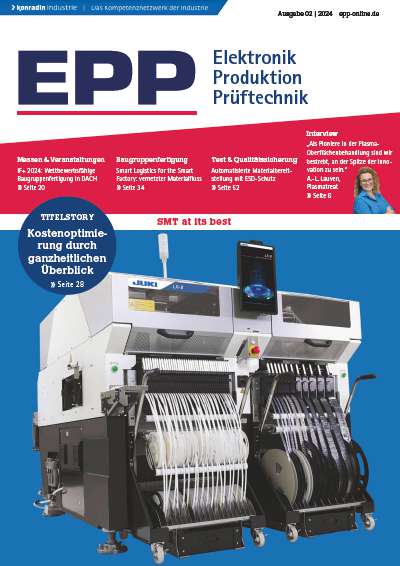A modular high-speed PCB test cell solution with a two-level conveyor allows optimal response to varying and unpredictable line capacity demands, while minimizing floor space and expenditure concerns.
Pekka Rytkonen, JOT Automation, Oulunsalo, Finland
As trends indicate, manufacturing volumes in the electronics industry will continue to increase, even there is a downturn now. What is less consciously considered however is that production line lengths and facility spaces are not increasing. This tends to create a problem with the continuously decreasing cycle times of the lines– especially when there are production phases that have longer cycle times, such as board test. With slight exaggeration, it could be said that complex board test can create problems similar to slow-moving tractors on high-speed roads.
Another current trend that is bound to cause problems is the increase in time with flash and PLD software (firmware) downloads and device programming. The increase in software extent as well as the final product customization by device programming – carried out at the production line backend – puts even more requirements on manufacturers automation equipment in achieving desired line beat rates.
Besides, continuous material flow is essential for getting the most out of all process equipment in a line. This is important since manufacturers are rarely willing to invest in new facilities in order to obtain more floor space. It has rather been the trend to increase line efficiency, while maintaining or even decreasing the length.
Therefore, board test has been on the verge of creating a potential material flow bottleneck. Line layouts have been difficult to design – and the outcome has always been a very complicated set of conveyors, bypasses, buffers and sometimes even lifts and gates around and over the test unit. The price of such solutions can also not be forgotten.
Small but beautiful
JOT has developed an answer for better management of these problems. The affordable Tiny test handler with less than 3.5s cycle time features a two-level board conveyor and a compact size of 0.5 x 0,8 x 1.5mm. With this module, the user takes into consideration the test handling requirements, as well as the optimization and control of the material flow in atest cell. Providing a two-level conveyor, where one conveyor level is for test purposes and the other serves as a by-pass, it offers high automation efficiency. The option of connecting several of these handling modules together allows an uninterrupted material flow even though the test time is longer than the line beat rate. This provides a fast, cost-efficient and optimally sized solution for test and device-programming tasks. The flexibility available is very high, and the design of the test cell layout is just a matter of adding handling modules to meet the capacity requirements set by the line beat rate and test time.
The lifetime flexibility of a test cell is also taken care of; the capacity of an existing line can be changed by replacing a conveyor segment with an additional handling module or vice versa. The line easily adapts to the normal changes of the production volumes during the life cycle of a product. This helps adapting the investments to the volume requirements of today, but upgrades of the line capacity can be made when they are actually needed. Tailoring equipment investments lead to cost savings and risk reduction.
From one module to the other
A test cell requires careful control of the material flow. With this solution, the first handler module acts as the control unit for the whole test cell. The other modules then are slaves to this master unit. When idling, all handler modules are waiting for a board, and are located in the home position. When a board arrives, the master takes the board and contacts it to the fixture pins, ready to test. When testing a board on the first conveyor level, the second level of the master operates in pass-through mode for the next board. The other handler takes the second board in and contacts it with the fixture. When test is finished for the first board, the master handler releases it and feeds the board to the lower-level conveyor of the second handler.
This operation guarantees an uninterrupted path for untested boards to the next available test station, and for the tested boards to the next production phase such as rework or magazining. The pass/fail status of the tested boards is forwarded with the SMEMA handshake protocol between the modules, and the separation of failed boards can be carried out directly after the test cell. A test handler like this can be used in a wide range of applications. Most beneficial is the use in processes that require contacting, and where the process time is larger than line cycle time.
Handling Flash and PLD
A good example is on-board programming; loading firmware into programmable devices (flash memories or PLDs) on the production line before test. Here, supplying the appropriate software after assembly is completed does the customization of the products. This strategy provides flexibility and makes logistics easier to control. However, as the quantity of firmware is getting even bigger, the programming turns into a bottleneck. A solution for the handling bottleneck is a module with two-level conveyors. Other pos-sible applications could be boundary-scan, built-in self test, boot-up test, functional test, pass/fail check, board mark-ing, etc., in principle, any verification which requires less probe contacts than ICT.
For implementing test contacts, the Tiny handler provides fast movement to create reliable probe contacts on top or bottom side of a board. The handler can manage forces up to 500N. In most cases, this isnot a limitation, as the fixture design allows the use of several connector actuators, which totals the possible test sig-nal count to several hundreds. In addition, a modular interface allows pneumatics, RF, high-voltage and high-current signals to be routed into the fixture.
The test cell makes it more risk-free and easy to automate some of the commontest procedures. So, electrical test is no longer a stage for which only very expe-rienced specialists can design processlayouts and optimize material flows, noris it highly expensive in regard to handling high quantities and rigid to modify.
EPP 165
Zuammenfassung
Ein großes Problem in Fertigungen ist der Platzbedarf für Produktionsequipment. Mit einem kompakten Boardhandler lassen sich Konfigurationen aufbauen, die nicht nur platzökonomisch sind, sondern auch noch viele andere Applikationen erlauben. Dazu gehört beispielsweise auch On-Board-Programmieren von Flash und anderen Speicherelementen mit Firmware während der Herstellung.
Résumé
L’encombrement des équipements de production représente un problème de taille dans la fabrication. Grâce à un manipulateur de circuits compact, il est possible de concevoir des configurations qui permettent non seulement de gagner de la place mais également de réaliser de nombreuses applications comme par exemple la programmation On-Board des mémoires flash et autres avec un progiciel durant la fabrication.
Sommario
Un grande problema nella produzione é rappresentato dalla necessità di spazio per le apparecchiature di produzione. Con un boardhandler compatto é possibile realizzare configurazioni non solo di ridotto ingombro ma che permettono anche molte altre applicazioni, come per esempio la programmazione On-Board di memorie Flash o di altre piattaforme di memoria con il Firmware durante la produzione.
Unsere Webinar-Empfehlung
Die 3D-Messung und Inspektion des Lotpastendrucks ist ein wichtiges Qualitätswerkzeug. Dieses funktioniert nur mit den richtigen Toleranzen und Eingriffsgrenzen.
Teilen:




.png)







